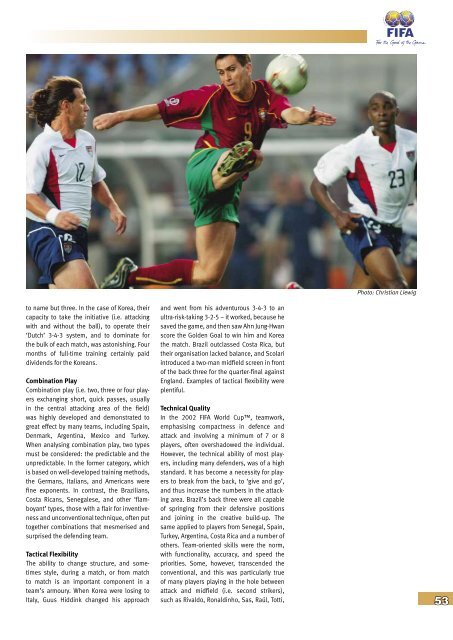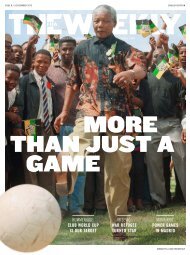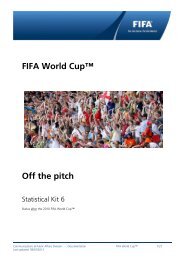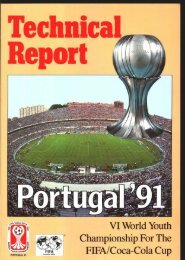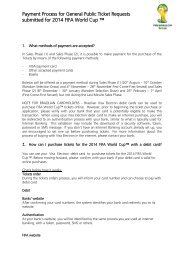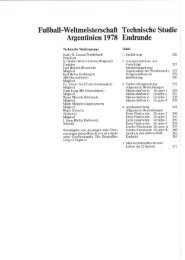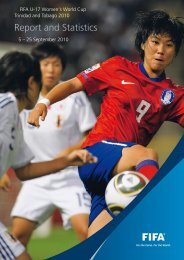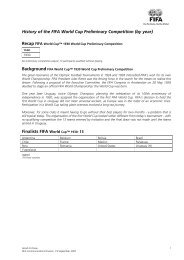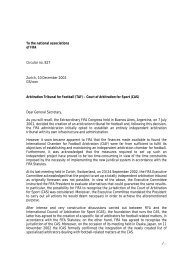You also want an ePaper? Increase the reach of your titles
YUMPU automatically turns print PDFs into web optimized ePapers that Google loves.
to name but three. In the case of Korea, their<br />
capacity to take the initiative (i.e. attacking<br />
with and without the ball), to operate their<br />
‘Dutch’ 3-4-3 system, and to dominate for<br />
the bulk of each match, was astonishing. Four<br />
months of full-time training certainly paid<br />
dividends for the Koreans.<br />
Combination Play<br />
Combination play (i.e. two, three or four players<br />
exchanging short, quick passes, usually<br />
in the central attacking area of the field)<br />
was highly developed and demonstrated to<br />
great effect by many teams, including Spain,<br />
Denmark, Argentina, Mexico and Turkey.<br />
When analysing <strong>com</strong>bination play, two types<br />
must be considered: the predictable and the<br />
unpredictable. In the former category, which<br />
is based on well-developed training methods,<br />
the Germans, Italians, and Americans were<br />
fine exponents. In contrast, the Brazilians,<br />
Costa Ricans, Senegalese, and other ‘flamboyant’<br />
types, those with a flair for inventiveness<br />
and unconventional technique, often put<br />
together <strong>com</strong>binations that mesmerised and<br />
surprised the defending team.<br />
Tactical Flexibility<br />
The ability to change structure, and sometimes<br />
style, during a match, or from match<br />
to match is an important <strong>com</strong>ponent in a<br />
team’s armoury. When Korea were losing to<br />
Italy, Guus Hiddink changed his approach<br />
and went from his adventurous 3-4-3 to an<br />
ultra-risk-taking 3-2-5 – it worked, because he<br />
saved the game, and then saw Ahn Jung-Hwan<br />
score the Golden Goal to win him and Korea<br />
the match. Brazil outclassed Costa Rica, but<br />
their organisation lacked balance, and Scolari<br />
introduced a two-man midfield screen in front<br />
of the back three for the quarter-final against<br />
England. Examples of tactical flexibility were<br />
plentiful.<br />
Technical Quality<br />
In the 2002 <strong>FIFA</strong> World Cup, teamwork,<br />
emphasising <strong>com</strong>pactness in defence and<br />
attack and involving a minimum of 7 or 8<br />
players, often overshadowed the individual.<br />
However, the technical ability of most players,<br />
including many defenders, was of a high<br />
standard. It has be<strong>com</strong>e a necessity for players<br />
to break from the back, to ‘give and go’,<br />
and thus increase the numbers in the attacking<br />
area. Brazil’s back three were all capable<br />
of springing from their defensive positions<br />
and joining in the creative build-up. The<br />
same applied to players from Senegal, Spain,<br />
Turkey, Argentina, Costa Rica and a number of<br />
others. Team-oriented skills were the norm,<br />
with functionality, accuracy, and speed the<br />
priorities. Some, however, transcended the<br />
conventional, and this was particularly true<br />
of many players playing in the hole between<br />
attack and midfield (i.e. second strikers),<br />
such as Rivaldo, Ronaldinho, Sas, Raúl, Totti,<br />
Photo: Christian Liewig<br />
53


